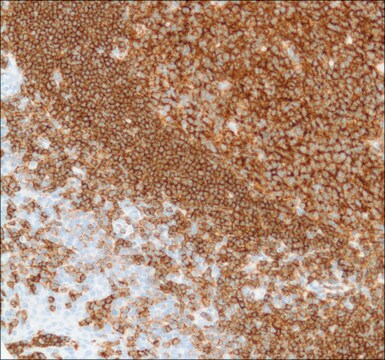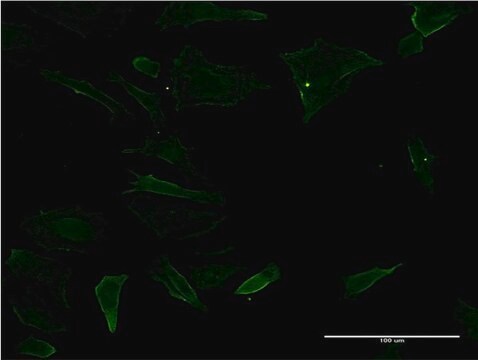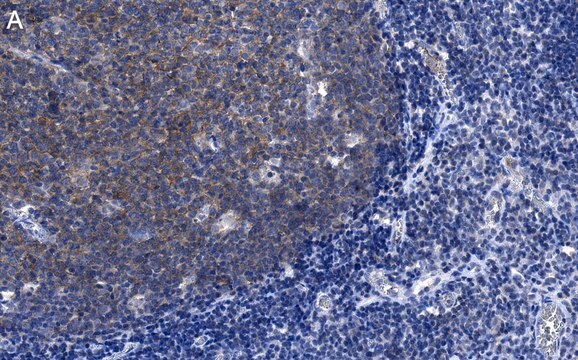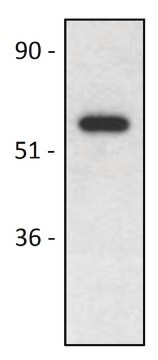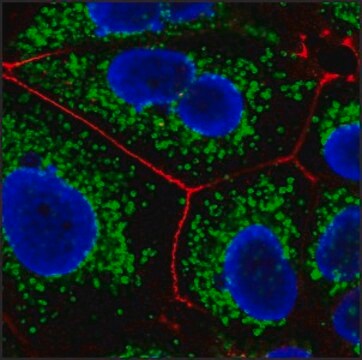SAB4700108
Monoclonal Anti-CD19 antibody produced in mouse
clone 4G7, purified immunoglobulin, buffered aqueous solution
Autenticatiper visualizzare i prezzi riservati alla tua organizzazione & contrattuali
About This Item
Codice UNSPSC:
12352203
NACRES:
NA.41
Prodotti consigliati
Origine biologica
mouse
Livello qualitativo
Coniugato
unconjugated
Forma dell’anticorpo
purified immunoglobulin
Tipo di anticorpo
primary antibodies
Clone
4G7, monoclonal
Stato
buffered aqueous solution
Reattività contro le specie
human
tecniche
flow cytometry: suitable
Isotipo
IgG1
N° accesso NCBI
N° accesso UniProt
Condizioni di spedizione
wet ice
Temperatura di conservazione
2-8°C
modifica post-traduzionali bersaglio
unmodified
Informazioni sul gene
human ... CD19(930)
Descrizione generale
CD19 (cluster of differentiation 19) is a 95kDa protein localized on the surface of nearly all B lymphocytes and is considered to be the specific surface marker for B cells.This protein belongs to the immunoglobulin (Ig) superfamily with a cytoplasmic region of ∼240 amino acids and is involved in the regulation of B cell function.The protein is encoded by the 7.41kb cd19 gene, mapped on the short arm of human chromosome 16p11.2. There are certain localized regions of strong net negative charges with nine tyrosine residues in the cytoplasmic region of CD19. These regions might regulate the interaction of CD19 with the proto-oncogene Vav, phosphatidylinositol-3 kinase (PI-3 kinase) and the Lyn, Lck and Fyn protein tyrosine kinases.
Immunogeno
Human CCL (chronic lymphocytic leukemia) cells
Applicazioni
The reagent is designed for Flow Cytometry analysis. Suggested working dilution is 1 μg/mL of sample. Indicated dilution is recommended starting point for use of this product. Working concentrations should be determined by the investigator.
Azioni biochim/fisiol
CD19 (cluster of differentiation 19) expression is restricted to normal and malignant B-lineage cells. Therefore, it is considered to be a striking target for immunotherapies aimed at B-cell malignancies. CD19 helps B lymphocytes to initiate primary immune response even at low concentrations of antigen.The encoded protein plays a crucial role in initiating intrinsic B cell signaling thresholds by regulating both B cell receptor (BCR)-dependent and independent signaling. It also functions as a biomarker for B-cell development.
Caratteristiche e vantaggi
Evaluate our antibodies with complete peace of mind. If the antibody does not perform in your application, we will issue a full credit or replacement antibody. Learn more.
Stato fisico
Solution in phosphate buffered saline, pH 7.4, with 15 mM sodium azide.
Esclusione di responsabilità
Unless otherwise stated in our catalog or other company documentation accompanying the product(s), our products are intended for research use only and are not to be used for any other purpose, which includes but is not limited to, unauthorized commercial uses, in vitro diagnostic uses, ex vivo or in vivo therapeutic uses or any type of consumption or application to humans or animals.
Non trovi il prodotto giusto?
Prova il nostro Motore di ricerca dei prodotti.
Codice della classe di stoccaggio
10 - Combustible liquids
Punto d’infiammabilità (°F)
Not applicable
Punto d’infiammabilità (°C)
Not applicable
Scegli una delle versioni più recenti:
Possiedi già questo prodotto?
I documenti relativi ai prodotti acquistati recentemente sono disponibili nell’Archivio dei documenti.
The CD19/CR2/TAPA-1 complex of B lymphocytes: linking natural to acquired immunity.
Fearon DT and Carter RH.
Annual Review of Immunology, 127-149 (1995)
CD19: a biomarker for B cell development, lymphoma diagnosis and therapy.
Wang K
Experimental Hematology & Oncology, 1 (2012)
The CD19/CD21 signal transducing complex of human B lymphocytes includes the target of antiproliferative antibody-1 and Leu-13 molecules.
Bradbury LE
Journal of Immunology, 149, 2841-2850 (1992)
CD19 monoclonal antibody HD37 inhibits anti-immunoglobulin-induced B cell activation and proliferation.
Pezzutto A
Journal of Immunology, 138, 2793-2799 (1987)
Yan Hu et al.
EMBO reports, 22(7), e52481-e52481 (2021-06-15)
Receptor activator of NF-κB ligand (RANKL) is essential for osteoclast formation and bone remodeling. Nevertheless, the cellular source of RANKL for osteoclastogenesis has not been fully uncovered. Different from peripheral adipose tissue, bone marrow (BM) adipose lineage cells originate from
Global Trade Item Number
| SKU | GTIN |
|---|---|
| SAB4700108-100UG | 4061832705910 |
Il team dei nostri ricercatori vanta grande esperienza in tutte le aree della ricerca quali Life Science, scienza dei materiali, sintesi chimica, cromatografia, discipline analitiche, ecc..
Contatta l'Assistenza Tecnica.